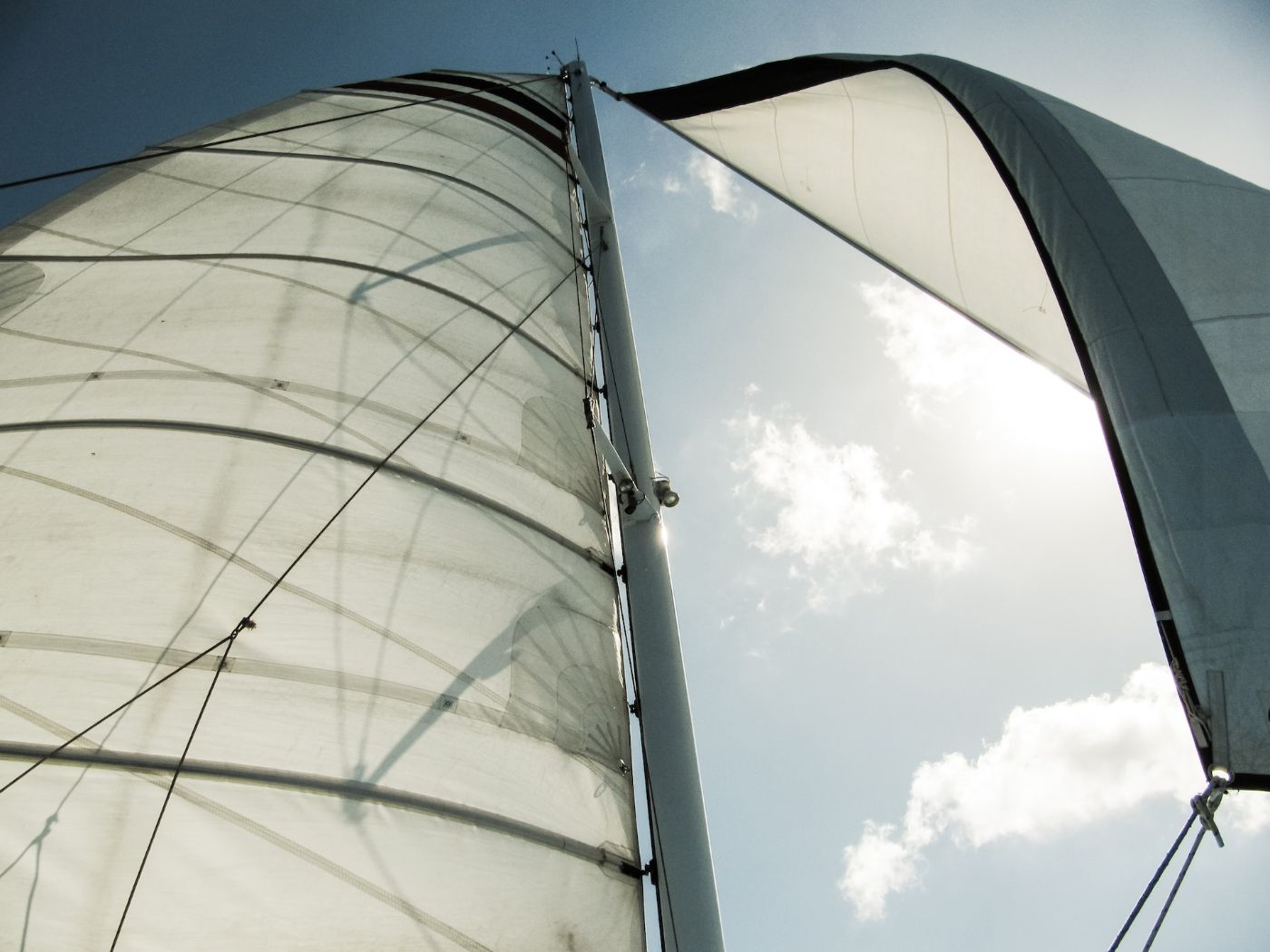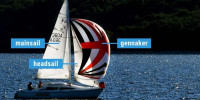Beam Reach vs Broad Reach: 3 Key Differences
If you are new to sailing and trying to understand the different points of sail, you may have come across the terms "beam reach" and "broad reach" and wondered what the difference is. While both points of sail involve sailing with the wind, they have some key differences that can affect your sailing strategy and performance.
During beam reach, the wind hits your boat from the side at a 90° angle, while in broad reach, the wind hits your boat from behind at a 135° angle. Your boat can also sail faster during beam reach than during broad reach. However, the beam reach experiences more drag, while the broad reach is more efficient.
When doing either broad reach or beam reach, you might need to be aware of instances that can cause your boat to suddenly turn or capsize. Let's learn about some safety precautions you need to keep in mind during beam reach and broad reach.
Summary
- On a beam reach, the boat can reach its maximum speed, but it can be uncomfortable for passengers due to the boat's heeling. On a broad reach, the boat is less likely to heel, making for a more comfortable ride; however, it may not be able to reach its maximum speed.
- A boat is more likely to ride over waves smoothly on a beam reach. Meanwhile, during a broad reach, it may roll sideways as it passes over waves.
- On a beam reach, you want to trim your sails so that they are perpendicular to the wind to maximize your speed and power. On a broad reach, you want to let your sails out a bit more so that they are at an angle to the wind to help you maintain your speed and stability.
- Experienced sailors may use a beam reach to maintain a consistent speed and direction when racing, or may use a broad reach to take advantage of strong winds when cruising.

On this page:
The Key Differences Between Beam Reach and Broad Reach
While beam reach and broad reach are two commonly used points of sail that seem similar at first glance, they have crucial differences in terms of the following:
| 3 Key Differences | Beam Reach | Broad Reach |
|---|---|---|
| Wind direction | Wind hits the boat from the side at a 90-degree angle to the course | Wind hits the boat from behind at an angle of around 135 degrees |
| Speed and power | Boat can sail at a faster speed, but may feel more unstable and harder to control | Boat may not travel as fast, but can still move at a decent speed and may feel more controlled and easier to handle |
| Drag and efficiency | Boat experiences more drag, making it more challenging to maintain the course and can slow it down | Boat experiences less drag, making it more efficient and easier to maintain the course |
1. They differ in terms of wind direction

During a beam reach, the wind is hitting your boat from the side, at a 90-degree angle to your course. In contrast, during a broad reach, the wind is hitting your boat from behind, at an angle of around 135 degrees. These differences in wind direction can affect your sail in relation to the following:
-
It can affect your maximum speed
On a beam reach, the sails are fully filled with wind, which means the boat is moving at its maximum speed. However, on a broad reach, the wind is coming from behind the boat, which means the sails are not as fully filled with wind, and the boat may not be able to reach its maximum speed.
-
It can affect comfortability
When sailing on a beam reach, the boat is heeled (tilted) to one side, which can be uncomfortable for passengers and may require more effort to keep the boat balanced. On a broad reach, the boat is less likely to heel, which can make for a more comfortable ride.
-
It can affect the boat's ability to handle waves
On a beam reach, the boat is more likely to ride over waves smoothly, while on a broad reach, the boat may be more likely to roll side-to-side as it passes over waves.
2. They differ in terms of speed and power

During a beam reach, your boat will be able to sail at a faster speed than during a broad reach. This is because the wind is hitting your sails more directly, allowing the sails to capture the full force of the wind, and therefore providing more power. However, the downside to this is that the boat may also feel more unstable and harder to control, especially in rougher waters.
On a broad reach, the wind is coming from behind the boat, which can result in a smoother and more stable sailing experience. The boat may not travel as fast as it would on a beam reach, but it can still move at a decent speed. Additionally, the boat may feel more controlled and easier to handle, which can be particularly important for novice sailors.
3. They differ in terms of drag and efficiency
During a beam reach, your boat will experience more drag since the wind is hitting your boat from the side. As the wind hits your sails at a right angle, it creates a lot of sideways force that needs to be counteracted by the keel and rudder. This can make it more challenging to maintain your course and can slow you down.
In contrast, during a broad reach, your boat will experience less drag, making it more efficient and easier to maintain your course. Since the wind is coming from behind the boat, it creates less sideways force and allows the boat to move more freely.
Tips for Sailing on a Beam Reach or Broad Reach

Since both beam reach and broad reach have an advantage over each other, here are some tips to help you sail on a beam reach or broad reach:
Adjust the sail trim for optimal performance
To achieve the best speed and power on a beam reach, you need to trim your sails properly. The sail trim should be adjusted so that the sail is perpendicular to the wind direction, and the sail's shape should be smooth and without any wrinkles. A slightly smoothed-out sail will reduce drag and increase efficiency, and can help maximize speed and keep your boat stable.
On a broad reach, you'll need to adjust your sail trim slightly differently. You may want to keep your sails at a slight angle to the wind, which means you'll need to trim them in slightly. This will help to prevent your boat from rounding up into the wind and keep you moving quickly.
For an in-depth guide on how to trim sails, here's an article for you.
Learn some steering techniques for different wind conditions
On a beam reach, you'll want to steer your boat directly downwind, which will help to keep your sails perpendicular to the wind and maximize your speed. You can adjust your course slightly to avoid waves or other boats, but be careful not to steer too far off course.
On a broad reach, you'll need to steer slightly differently. You want to keep your boat at a slight angle to the wind, which means you'll need to steer slightly upwind. This will help to prevent your boat from rounding up into the wind and keep you moving quickly.
Practice safety precautions
During a beam reach, you'll need to be aware of the risk of jibing, which can occur if the wind catches the back of your sail and causes your boat to turn suddenly. To avoid this, try to keep a close eye on the wind and adjust your sail trim as necessary.
Meanwhile, on a broad reach, you'll need to be aware of the risk of broaching, which can occur if your boat turns too far into the wind and capsizes. To avoid this, you may want to keep your boat at a slight angle to the wind and adjust your course as necessary.
You can read more about accidental jibe and the risk of broach in this article: Why Is Sailing Close to the Wind Dangerous?
Beam Reach vs. Broad Reach For Different Experience Levels

Both have their advantages and disadvantages, and which one is better depends on a number of factors, including the experience level of the sailor and the conditions on the water.
Beam reach is easier for beginners
Beam reaching is generally considered to be easier for beginners, as it requires less skill and experience to maintain control of the boat. It is also a good technique to use in moderate winds, as it allows the boat to move quickly without excessive heeling.
On the other hand, a broad reach is more challenging for beginners, as it requires more skill and experience to maintain control of the boat. It is a technique best used during strong winds.
Intermediate sailors can do both beam reach and broad reach
For intermediate sailors, both beam-reaching and broad-reaching can be good options, depending on the conditions of the water.
If the wind is strong, intermediate sailors may want to use the beam-reaching technique, as it allows the boat to move quickly and efficiently through the water. On the other hand, if the wind is light, they may want to use the broad-reaching technique, as it allows the boat to move steadily and efficiently through the water without being overpowered by the wind.
Intermediate sailors must strive to practice both techniques and become comfortable with them, so they can adapt to changing conditions and make the most of their time on the water.
Experienced sailors can switch between a beam reach and broad reach depending on their goals
Experienced sailors may use a beam reach to maintain a consistent speed and direction when racing. This is because the boat is able to sail at a high speed while still maintaining a relatively stable course.
On the other hand, they may use a broad reach to take advantage of strong winds when cruising. Since the boat can sail at a high speed with the wind pushing it from behind, it can make for a more comfortable and efficient ride.
For example, if a sailor is racing in a regatta and wants to maintain a consistent speed and direction, they may use a beam reach to stay on course. However, if the wind picks up and becomes strong, they may switch to a broad reach to take advantage of the strong winds and sail at a faster speed.
Did you find the answer to your specific question?
👍 0 👎 0




Leave a comment